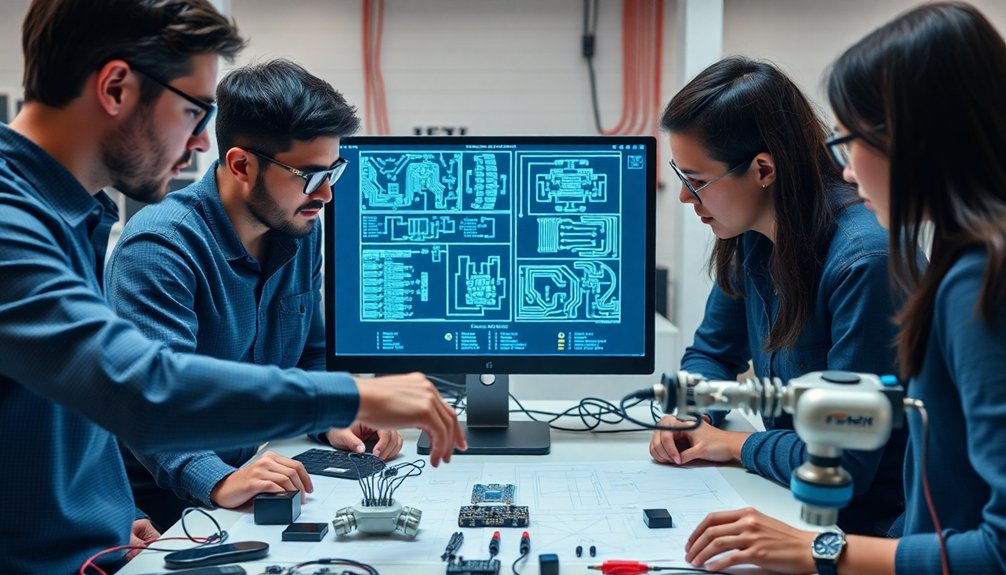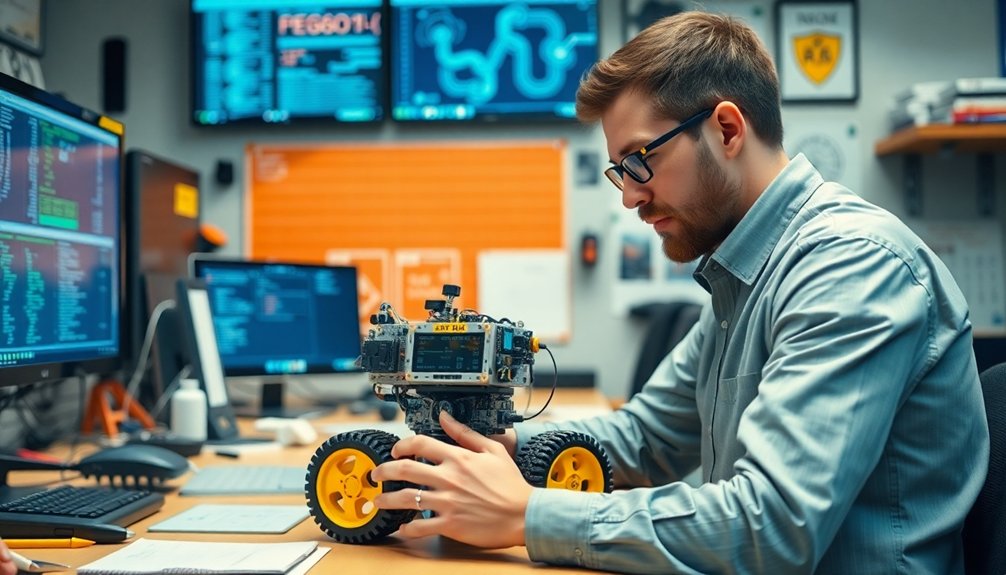Table of Contents
Programming a robot isn’t just about code—it’s building an electronic brain from scratch. You’ll need programming languages like Python and C++, electronic components that act as sensory networks, and frameworks like ROS that transform hardware into intelligent systems. Safety protocols are essential: think emergency stops and sensor-driven protections. Design with ethics in mind, prototype aggressively, and remember: your robot’s potential is limited only by your imagination.
Picking the Right Programming Toolbox

Ever wondered how robots actually learn to do cool stuff? Your software framework is like a robot’s brain training manual.
Think of ROS as the Swiss Army knife of robotics – it helps machines understand commands and move smoothly.
But here’s the trick: you can’t just grab any framework. It’s gotta match your specific robot’s hardware and mission.
MATLAB’s great for research nerds, PyRobot rocks for AI enthusiasts, but each tool has its personality.
Want your robot to recognize objects? You’ll need different muscles than if you’re building a factory bot.
The right framework isn’t just code – it’s a blueprint for turning metal and circuits into something that can think, adapt, and maybe even outsmart its human creators.
Software integration capabilities will determine how seamlessly your robot interacts with different systems and sensors.Robot programming frameworks often include specialized libraries for advanced sensor fusion and machine learning integration.Neural network architectures enable robots to transform raw sensory data into intelligent adaptive behaviors through continuous learning.
Choose wisely.
Electronic Foundations for Robotic Intelligence
So you’ve picked your robot’s software brain—now let’s wire up its nervous system. Think of electronic foundations like the robot’s spinal cord and sensory network. NVIDIA Isaac technologies provide advanced frameworks for integrating these complex robotic systems with intelligent perception and learning capabilities.
You’ll need sensors to help it see, touch, and understand its world: cameras that capture visual data, proximity sensors that detect nearby objects, and communication interfaces that let different robot parts chat. Course projects involve designing comprehensive sensor integration strategies that mirror real-world robotic challenges. Sensor fusion techniques enhance the robot’s ability to perceive and interact with its environment more effectively.
Microcontrollers are basically the robot’s mini-brain, processing sensor information and deciding how to move. Actuators are its muscles, translating computational decisions into physical motion.
And don’t forget power—without a solid energy supply, your robot’s going nowhere fast. Each component works together like a complex, silicon-based organism, transforming lines of code into something that can actually interact with the real world.
Core Programming Languages and Logic

When you’re building a robot, choosing the right programming language is like picking the perfect brain for a silicon-powered sidekick. C/C++ are your go-to for hardcore performance, offering lightning-fast interactions with hardware.
Python swoops in as the friendly wizard, letting you prototype and script with ease. Want cross-platform flexibility? Java’s got your back, sliding smoothly into AI and network-enabled systems.
But here’s the real secret: it’s not just about languages—it’s about logic. Neural networks simulate advanced learning mechanisms that transform robots from simple machines into adaptive problem-solvers with intelligent decision-making capabilities.
Your robot needs a brain that can make split-second decisions, adapt to wild environments, and potentially learn from its mistakes. Industrial robot languages like RAPID and KRL provide specialized frameworks for precise robotic control and functionality.
Think feedback loops, smart algorithms, and the kind of intelligence that turns mere machinery into something almost alive. Robotic programming isn’t coding. It’s creating digital consciousness. Specifically, hardware description languages play a crucial role in programming the electronic foundations that make robotic systems possible.
Advanced Robotics Frameworks and Platforms
Imagine building your own robot using ROS, the Swiss Army knife of robotics, or diving into NVIDIA Isaac SDK’s AI-powered playground. Modular architecture frameworks enable developers to create complex robotic systems with interchangeable components and standardized communication protocols. Want to simulate before you build? Unity and Webots let you test wild robot scenarios without risking your hardware. Advanced robotics platforms like Arduino and Raspberry Pi provide accessible entry points for developers to experiment with robotic system design and implementation.
Robotics dreamers: Your digital playground awaits with ROS, NVIDIA Isaac, Unity, and Webots — where imagination meets innovation.
These frameworks aren’t just tools; they’re your digital robotics workshop. Sensor fusion techniques allow robots to integrate multiple data streams, enhancing their perception and adaptability beyond traditional programming limitations. OpenCV helps your robot see, Raspberry Pi lets you build on a budget, and ROS2 brings next-level performance.
TensorFlow integration means your robot can learn, adapt, and potentially outsmart you. Just don’t get too attached — today’s cutting-edge robot is tomorrow’s recycling project.
Designing Safe and Ethical Robotic Systems

When you’re building robots, ethical design isn’t just a checkbox—it’s the difference between creating a helpful companion and accidentally spawning a tech nightmare. Addressing potential robot behavioral risks means anticipating how your creation might interact with humans in unexpected scenarios. You’ll want to prioritize safety features that make your robot more predictable than a well-trained golden retriever, ensuring it won’t accidentally knock over your grandma or decide to redecorate your living room with its mechanical limbs. From fail-safe mechanisms to crystal-clear interaction protocols, your goal is designing robotic systems that are less “sci-fi horror movie” and more “trustworthy technological assistant”. Algorithmic decision-making requires careful oversight to minimize potential biases and ensure the robot’s actions align with ethical standards. Incorporating IEEE ethical standards ensures your robotic design meets global guidelines for responsible automation and human-robot interaction.
Ethical Robot Design
As robots creep closer to becoming our everyday companions, ethical design isn’t just a nerdy checkbox—it’s the difference between a helpful sidekick and a potential nightmare scenario.
You’ll want robots that respect human dignity, protect privacy, and avoid turning into bias-spewing machines that discriminate faster than a middle school gossip network.
Designing ethical robots means creating transparent systems where decision-making isn’t some mysterious black box. It’s about building machines that understand cultural nuances, operate efficiently, and genuinely contribute to society.
Think of it like training a super-smart puppy: you’re teaching it to play nice, respect boundaries, and not destroy everything in its path.
The future isn’t just technological—it’s fundamentally human.
Safety First Approach
If robots are going to share our world, they’d better come with some serious safety guardrails. You can’t just toss machines into human spaces without thinking through potential risks.
That means hardcore risk assessments from day one, tracking every possible hazard like a detective hunting clues. Think protective barriers, emergency stop buttons, and sensors that can detect a human faster than you can blink.
It’s about building safety into the robot’s DNA, not slapping on warning stickers as an afterthought. Whether it’s industrial robots or home assistants, the goal is creating systems that won’t randomly decide to turn on you.
Smart design means redundant safety mechanisms, intuitive interfaces, and constant vigilance. Because let’s be real: nobody wants a robot apocalypse happening in their living room.
Practical Development and Implementation Strategies
You’re about to transform a pile of hardware and code into something that actually moves and thinks—welcome to robot design strategy.
Your development journey isn’t just about wiring circuits or writing perfect algorithms, but about crafting an intelligent machine that can solve real-world problems with minimal human handholding.
Mastering this process means understanding that every robotic creation is part technical challenge, part creative puzzle, and entirely an opportunity to push the boundaries of what technology can achieve.
Robot Design Strategy
When designing a robot from scratch, strategy isn’t just a fancy buzzword—it’s your blueprint for turning wild ideas into working machines.
You’ll need to define crystal-clear goals and select mechanisms that solve multiple tasks without creating a Frankenstein’s monster of complexity.
Think of your robot like a Swiss Army knife: versatile, but not overcomplicated.
Prototype aggressively, test ruthlessly, and be ready to scrap designs that don’t make the cut.
Prioritize performance metrics that actually matter—energy efficiency, reliability, and adaptability.
Material selection isn’t just about durability; it’s about creating a lean, mean robotic machine that can pivot faster than a startup’s business model.
Remember: every component should earn its place, or it gets eliminated.
Simplicity is your secret weapon.
Development Process Mastery
After sketching out your robot’s blueprint, you’re ready to transform paper dreams into silicon reality. Mastering the development process isn’t just coding—it’s creating digital life from scratch. Your journey involves translating abstract ideas into precise mechanical instructions that’ll make your robotic creation move, think, and potentially judge humanity (just kidding… maybe).
Key development checkpoints include:
- Mapping out each component’s communication pathway like a digital nervous system
- Creating modular code segments that snap together like LEGO blocks of logic
- Establishing rigorous testing protocols that’ll expose every potential weakness
Think of programming as part engineering, part art—you’re fundamentally teaching metal and circuits how to dance to your algorithmic choreography. Each line of code is a whispered instruction, each function a potential moment of robotic brilliance.
Continuous Learning and Technical Refinement

Because robots aren’t born smart, they’ve got to learn—and that’s where continuous learning gets seriously cool.
Imagine robots that can adapt faster than a chameleon changes colors. These machines aren’t just following pre-programmed scripts; they’re developing skills on the fly, learning from experiences like tiny mechanical students.
Technical refinement means your robot can tackle complex tasks by constantly upgrading its own algorithms. It’ll analyze past performance, spot weaknesses, and improve—kind of like a workout routine for artificial intelligence.
Robots flexing their AI muscles, self-improving like digital athletes leveling up their algorithmic performance.
Whether in a factory, classroom, or research lab, these adaptive robots are breaking traditional programming boundaries.
The future? Robots that learn, modify, and excel without constant human intervention. Pretty mind-blowing, right?
People Also Ask
How Much Does It Cost to Start Building a Robot From Scratch?
You’ll spend between $500 and $100,000 depending on your robot’s complexity, with budget kits starting around $500 and industrial robots costing up to six figures. Open-source software can help reduce initial expenses.
Can I Learn Robotics Programming Without an Engineering Background?
Ever wondered if passion trumps pedigree? You absolutely can learn robotics programming without an engineering background. Online courses, self-study resources, and practical projects will help you bridge the skills gap.
What’s the Most Beginner-Friendly Robot Platform for Newcomers?
You’ll find LEGO Mindstorms the most beginner-friendly platform. It’s intuitive, offers drag-and-drop coding, and lets you build creative robots using familiar LEGO bricks, making learning robotics fun and accessible.
How Long Does It Typically Take to Build a Basic Robot?
You’ll need about 2-4 weeks to build a basic robot, depending on your design complexity, programming skills, and available components. Your progress varies based on prior experience and project sophistication.
Do I Need Advanced Math Skills to Program Robots?
85% of robotics engineers use advanced math daily. You’ll need strong calculus, linear algebra, and trigonometry skills to design complex robotic systems and solve intricate programming challenges effectively.
The Bottom Line
You’ve got the power to turn lines of code into living, thinking machines. Robotics isn’t just about circuits and algorithms—it’s about creating intelligence from scratch. When you nail the right programming tools and ethical frameworks, you’ll be cooking with gas in the world of robotic development. Keep learning, stay curious, and watch your digital creations come to life.
References
- https://www.toptal.com/robotics/programming-a-robot-an-introductory-tutorial
- https://www.create-learn.us/blog/robotics-and-coding/
- https://standardbots.com/blog/how-to-program-a-robot
- https://www.playtolabs.com/blog/robotics-for-beginners
- https://www.youtube.com/watch?v=J0ssFp7yN8Y
- https://flr.io/articles/choosing-the-right-robot-programming-simulation-software
- https://standardbots.com/blog/robotics-tools
- https://www.reduct.store/blog/data-management-tools
- https://robodk.com/forum/Thread-Comparison-with-simulation-software-from-each-robot-manufacturer
- https://formant.io/blog/best-robot-simulators/
